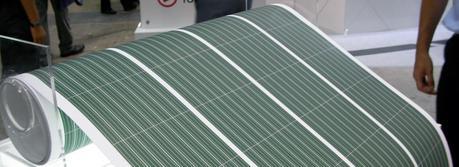
Flexible solar cell developed by Japanese company PV Japan (Credit: Marufish, http://www.flickr.com/photos/marufish/).
A technology developed by the HiFlex research project promises flexible, lightweight, on-the-go charging for mobile electronics and remote applications. New organic photovoltaic module (OPV) is relatively cheap and can effectively function under various light conditions.
The project—a collaboration between ECN, Fraunhofer Institute for Solar Energy Systems (ISE), TNO / Holst Centre, Technical University of Denmark (DTU), Pera Technology / The UK Materials Technology Research Institute (UK-MatRI), Dr. Schenk and Agfa Gevaert—was supported by the European Commission as part of the FP7 Information and Communication Technologies (ICT) Programme.
The project has overcome a number of the key challenges towards the commercialisation of this technology as the modules are fully roll to roll (R2R) processed, indium free, and demonstrate good outdoor stability.
Jan Kroon from ECN, project coordinator for Hiflex says: “Our consortium has developed a relatively low cost module which will significantly accelerate the take up of OPV technology in the mobile electronics market and will also find future applications with other products such as leisure and building industries to name but a few.”
A key feature of the Hiflex project is the removal of indium tin oxide (ITO) which is used as a transparent conductive layer in other OPVs. ITO is very expensive and there are concerns about future supplies of Indium, so removing ITO has been key to the cost effectiveness and long term viability of the Hiflex technology. In addition, silver has also been removed from the production process of small credit card sized modules, further reducing costs and potential resource supply issues. Overall, the approach also demonstrates significantly lower embedded energy than competing technologies.
To ensure increased process efficiency and performance and to keep costs under control, testing tools have been built into the production process, which analyze the material for any faults. In particular Hiflex partner Dr. Schenk has installed their SolarInspect RollToRoll Metrology System within DTU’s (Technical University of Denmark) inline printing and coating system.
Kroon continues: “We’ve made some technological breakthroughs in OPV development here, without losing sight of the user requirements, both in terms of the film’s performance and quality but also regarding production costs, which could limit applications if too high.”
The Hiflex consortium held a final dissemination event in Eindhoven in December 2012 to demonstrate the modules and discuss issues around OPV development and commercialisation. As well as attracting other research and technology organisations, the event also attracted a good number of potential end users such as building products and solar canopy manufacturers in addition to mobile electronics producers.
Gevorgyan, S., Medford, A., Bundgaard, E., Sapkota, S., Schleiermacher, H., Zimmermann, B., Würfel, U., Chafiq, A., Lira-Cantu, M., Swonke, T., Wagner, M., Brabec, C., Haillant, O., Voroshazi, E., Aernouts, T., Steim, R., Hauch, J., Elschner, A., Pannone, M., Xiao, M., Langzettel, A., Laird, D., Lloyd, M., Rath, T., Maier, E., Trimmel, G., Hermenau, M., Menke, T., Leo, K., Rösch, R., Seeland, M., Hoppe, H., Nagle, T., Burke, K., Fell, C., Vak, D., Singh, T., Watkins, S., Galagan, Y., Manor, A., Katz, E., Kim, T., Kim, K., Sommeling, P., Verhees, W., Veenstra, S., Riede, M., Greyson Christoforo, M., Currier, T., Shrotriya, V., Schwartz, G., & Krebs, F. (2011). An inter-laboratory stability study of roll-to-roll coated flexible polymer solar modules Solar Energy Materials and Solar Cells, 95 (5), 1398-1416 DOI: 10.1016/j.solmat.2011.01.010
